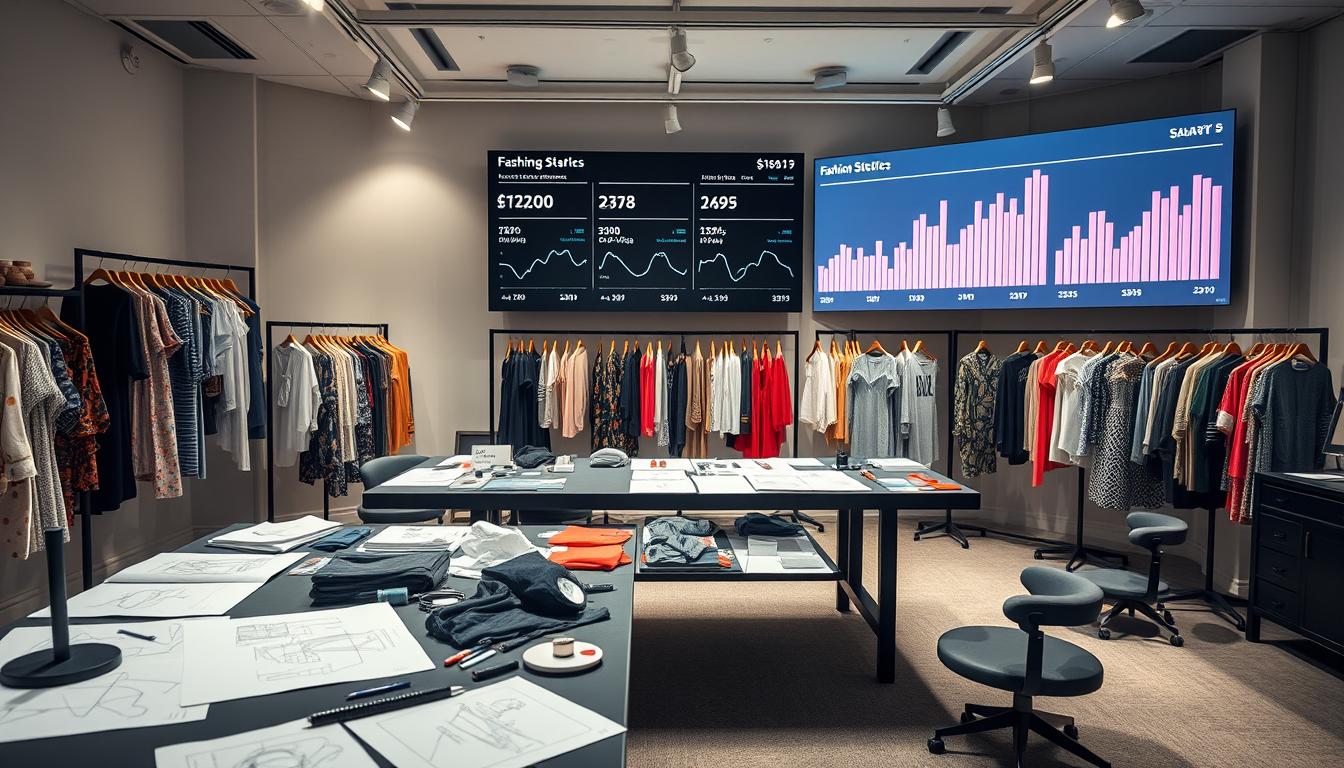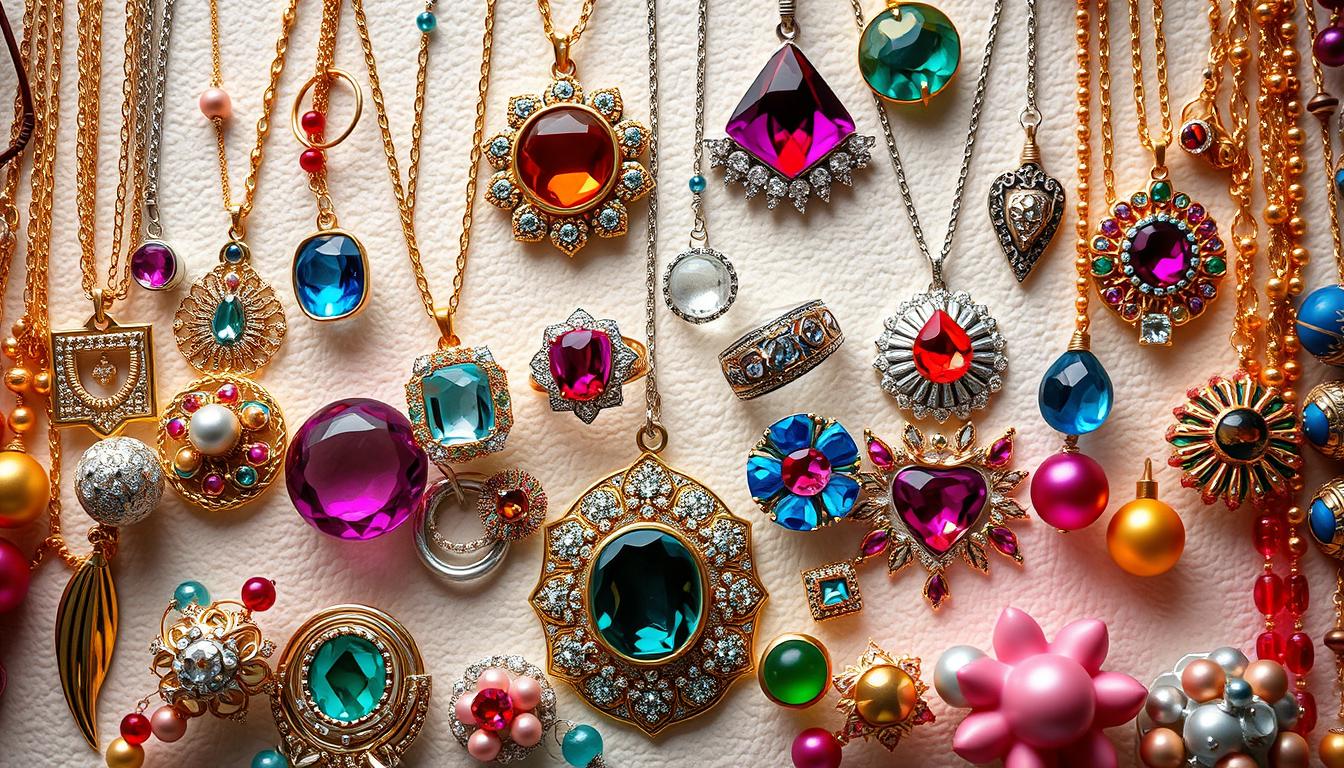As a fashion designer, you shape the clothes, accessories, and shoes that show our style and culture. The financial side of this field is just as interesting. Salaries for fashion designers can change a lot, from entry-level to high-end luxury.
This range offers many chances for those with the right skills and experience.
Key Takeaways
- Fashion designer salaries can range from $35,000 for entry-level roles to over $120,000 for experienced, senior-level positions.
- Factors such as location, industry focus, and educational background can significantly impact earning potential.
- Specialization in areas like sustainable fashion or costume design can lead to higher earning capacity.
- Combining full-time and freelance work can provide both financial stability and creative autonomy.
- Continued education, networking, and effective marketing strategies can help fashion designers maximize their salary prospects.
Overview of Fashion Design as a Career
Fashion design is a dynamic field that involves creating clothes and accessories. Designers shape the style of our garments, drawing from trends and consumer preferences. They work in big fashion houses, small labels, or start their own businesses, turning ideas into wearable art.
What Does a Fashion Designer Do?
Fashion designers do many things. They start by studying trends and what people like. They then create designs, often using computer software.
After that, they pick the right fabrics and colors for their designs. They also make sure the products are made well before they hit the market.
Skills Required for Success
To be a successful fashion designer, you need creativity, technical skills, and business smarts. You must be able to think creatively and come up with designs that people love.
You also need to know how to use design software and understand how clothes are made. Good communication skills are key, as designers work with many people.
Types of Fashion Design Fields
The fashion world has many specializations, each with its own rewards. Apparel designers make clothes for everyone, while accessory designers focus on bags, jewelry, and shoes.
Costume designers create outfits for movies and TV, and sustainable fashion designers focus on eco-friendly clothes. This variety lets designers follow their interests and find fulfilling careers.
Salary Expectations by Experience Level
Starting a career in fashion design? Knowing the salary ranges by experience is key. Whether you’re new or have years of experience, the fashion world offers different earning possibilities.
Entry-Level Salary Insights
Newbies or those with 1-2 years of experience can earn $35,000 to $50,000 a year. This range is for those starting to build their portfolio and skills.
Mid-Career Salary Trends
Designers with 3-7 years of experience can make $50,000 to $80,000 a year. This is for those who have improved their skills and gained industry knowledge.
Senior-Level Earnings Overview
Designers with 7-10 years of experience can earn $80,000 to $120,000 or more. These experts are known for their top-notch design and leadership skills. In luxury fashion, some designers can make over $200,000.
Salaries also depend on location, specialization, and the brand’s reputation. Freelancers can earn more based on their project success.
| Job Title | Median Salary |
|---|---|
| Fashion Designer | $70,229 |
| Film Director | $79,000 |
| Interior Designer | $60,000 |
| Architect | $80,000 |
Knowing these salary ranges helps designers plan their careers. It guides them in making choices about their growth and earnings in the fashion world.
Geographic Influence on Salary Prospects
Location greatly affects fashion design salaries. Cities like New York and Los Angeles pay more because of high demand and living costs. The top states for fashion designer salaries are New Hampshire, New Jersey, and Washington.
High-Paying Locations for Fashion Designers
In the U.S., fashion designers earn an average of $70,229 yearly. But, some places offer better pay. Massachusetts and Oregon are among these, with salaries over $80,000.
Cost of Living Considerations
It’s key to think about living costs when looking at salaries. A high salary in an expensive city might not go as far as a lower salary in a cheaper area. Designers should consider this when choosing jobs.
Remote Work Opportunities
Remote work is changing the fashion industry. It lets designers work from anywhere and still earn good pay. This could open up more job chances in places outside big fashion cities.

“The fashion industry is evolving, and remote work is becoming more prevalent. Designers now have the chance to earn competitive salaries while enjoying a better quality of life in more affordable areas.”
Impact of Industry on Salary
The fashion world is big and varied, with different jobs paying differently. Fashion retail and luxury brands have different pay levels. But, the growing green fashion trend is creating new chances for designers.
Fashion Retail vs. High Fashion
Designers in mass-market retail might earn less than those in high-end fashion. Luxury brands pay more because they invest in their talent. But, living costs in big fashion cities like New York and Paris can be high.
Influencer and Celebrity Designer Earnings
Influencer culture and celebrity designers have brought new money-making chances. Designers can make more by using their personal brands and working with labels. This can greatly change how much they can earn.
Salaries in Sustainable Fashion
- The green fashion trend is getting bigger, thanks to people wanting eco-friendly and fair clothes.
- Designers who know about green materials and ways to make clothes can get good pay in this field.
- As more people want green fashion, there will be more chances for designers to earn well in this area.
For fashion designers, knowing the fashion world well is key to making more money. Understanding the different areas, new trends, and special skills can lead to better pay. This can help designers earn more and have better career chances.
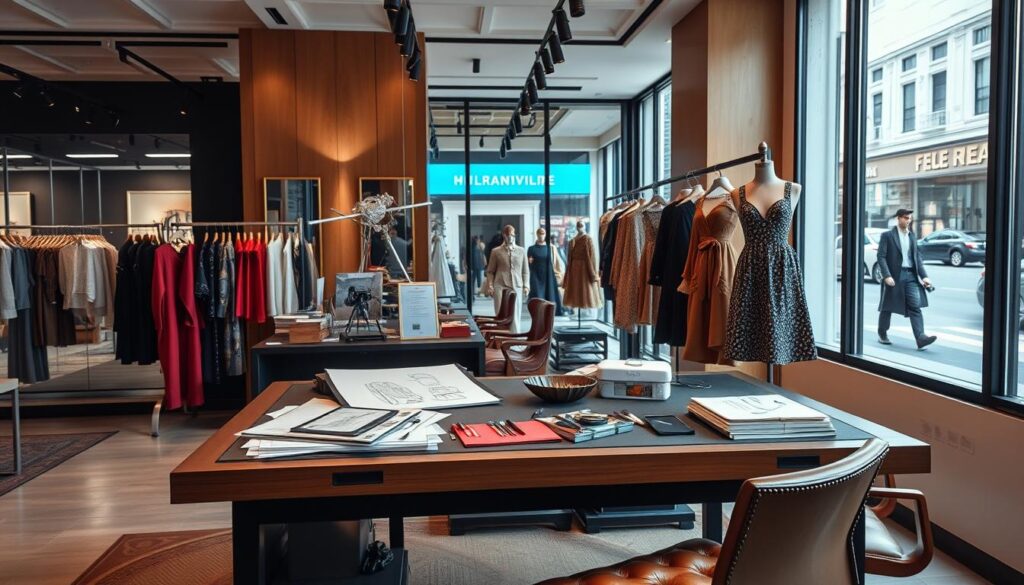
Educational Background and Its Effect on Salary
Getting a degree in fashion design can really boost your career and pay. Both online and traditional schools have their own perks. They fit different learning styles and schedules.
Importance of a Degree in Fashion Design
Over 350 U.S. schools have accredited fashion design programs, says the National Association of Schools of Art and Design (NASAD). Most fashion designers have a bachelor’s degree, which is 61% of them. A fashion design degree teaches you important skills like creativity and teamwork.
Online vs. Traditional Education Paths
On-campus programs offer hands-on learning and networking. But, online programs are getting more popular. They let you study from home, saving money and time. Your choice depends on how you learn best, your budget, and your lifestyle.
Internships and Real-World Experience
Internships are key, no matter your education. They help you build a portfolio and make industry contacts. This experience can lead to better pay and faster promotions, as employers value practical skills.
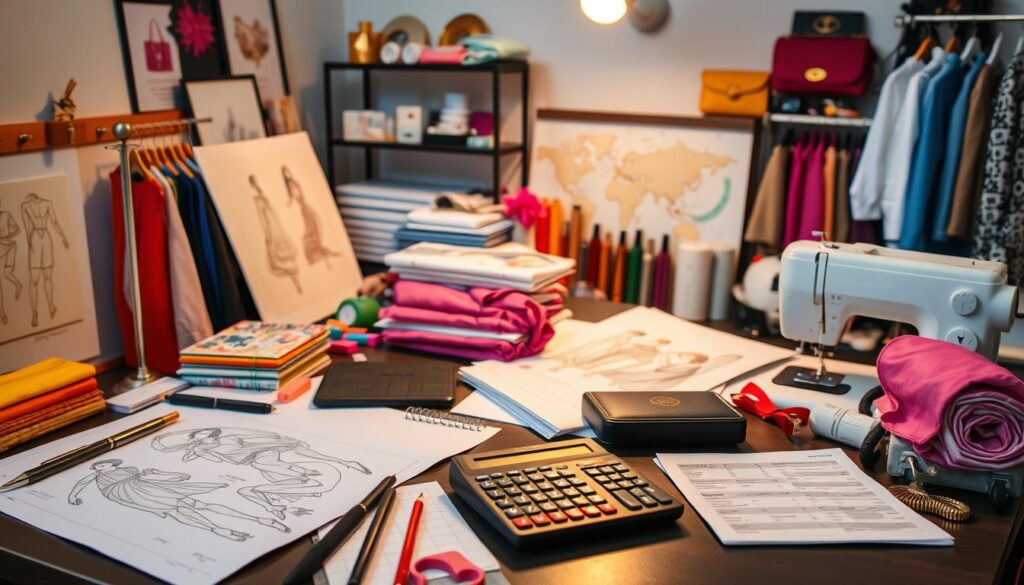
| Degree Level | Percentage of Fashion Designers |
|---|---|
| Bachelor’s Degree | 61% |
| Associate Degree | 22% |
| Master’s Degree | 7% |
Skills and Certifications That Boost Earnings
To succeed in fashion design, you need more than just creativity. Skills in computer-aided design (CAD), pattern-making, and textiles are key. These skills make a designer more valuable and can increase their pay.
Technical Skills in Demand
Designers who are good with CAD software like Adobe Creative Suite are in high demand. They also need to know about pattern-making and draping. Knowing about textiles, fabric sourcing, and production can also raise apparel designer compensation.
Specialized Certifications
Getting specialized certifications can help designers earn more. Certificates in sustainable design, digital fashion, or luxury brand management show you’re up-to-date. They prove you’re ready for the market’s changes.
Importance of Networking
In fashion, networking is vital. It can lead to better jobs and higher pay. Building a strong network, working with peers, and keeping in touch with big names can open doors. This can lead to big projects and more money.
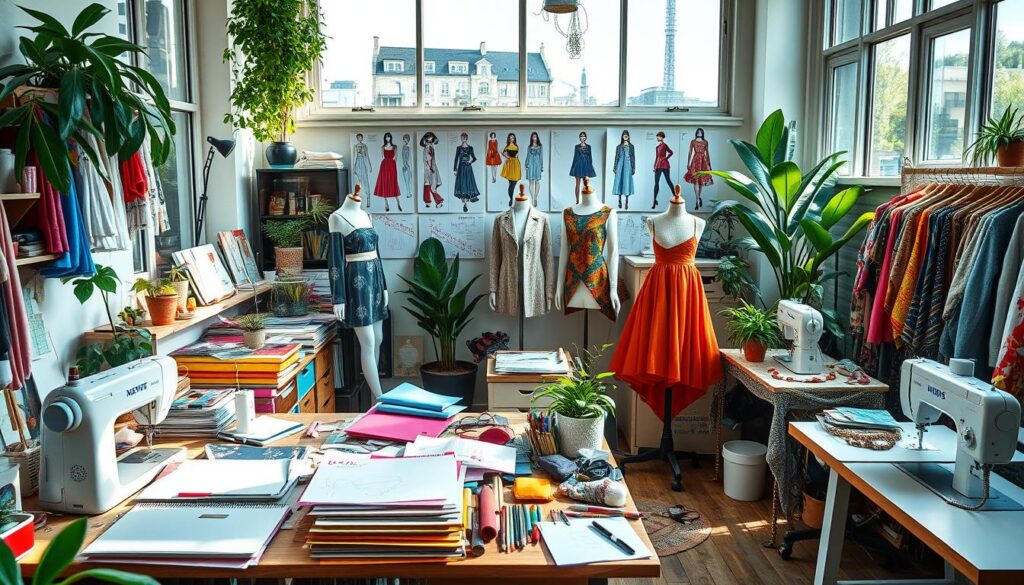
“Successful fashion designers are not just creative visionaries; they are also savvy business professionals who understand the value of their technical expertise and industry connections.”
Job Roles Within Fashion Design
The fashion industry has many job roles, each with its own salary and career growth. You can find jobs from fashion designers to merchandisers and production managers. It’s a field full of opportunities for those who love style and design.
Fashion Designer vs. Fashion Merchandiser
Fashion designers create the clothes and accessories we love. They think up designs, pick fabrics, and manage production. In the U.S., they make about $65,170 a year.
Fashion merchandisers handle the business side. They manage stock, prices, and where products go. Their salaries range from $53,203 to $75,000, based on experience and role.
Roles in Fashion Production and Development
The industry also has roles in production and development. Garment pattern specialists make between $40,000 and $100,000 a year. Fashion illustrators can earn up to $73,200.
Textile designers usually make about $50,500 a year.
Career Progression Opportunities
- Fashion designers can become senior designers, creative directors, or even start their own brands. This can greatly increase their earnings over time.
- Merchandisers can move up to become buyers, category managers, or retail store managers. Salaries can range from $53,203 to $100,000.
- Roles in production and development, like textile design or fashion illustration, can lead to higher-paying positions or management roles.
The fashion industry offers many job roles and salaries. It’s perfect for those who love creativity, business, and detail. Whether you dream of being a designer, merchandiser, or production specialist, there’s a rewarding career path for you.
| Job Role | Average Annual Salary |
|---|---|
| Fashion Designer | $65,170 |
| Fashion Merchandiser | $53,203 – $75,000 |
| Garment Pattern Specialist | $40,000 – $100,000 |
| Fashion Illustrator | $73,200 |
| Textile Designer | $50,500 |
Understanding Salary Negotiation
Salary negotiation is key to a fashion designer’s earnings. As a style creator, knowing the industry standards is crucial. You should also highlight your skills and achievements. Timing your salary talks right is important too.
Use data from reports, associations, and websites to prepare. This helps in negotiating a fair designer pay scale.
Tips for Negotiating Your Salary
Negotiating salary can be tough, but it’s part of the job. Here are tips to help you:
- Know your worth by looking at your experience, skills, and how they match the job.
- Show how your past work has brought value to your employers to strengthen your case.
- Don’t talk about money too soon. First, show what you can do.
- Look at the whole job, not just the salary. Consider the work environment, culture, and chances for growth.
- When making counter-offers, focus on your value and a solid proposal.
When to Discuss Salary
When to talk about salary is very important. Most negotiation work happens before you meet. It’s best to wait until you get an offer to discuss pay.
This way, you can show your worth first. Then, you can negotiate your designer pay scale and other benefits.
Resources for Salary Research
| Resource | Description |
|---|---|
| Bureau of Labor Statistics | Provides wage data by area and occupation for over 800 occupations in about 400 industries. |
| Glassdoor | Offers salary information based on reviews and ratings shared by current and former employees. |
| Payscale | Allows individuals to compare salaries past, present, and future. |
| Salary.com | Provides salary reports for various career fields, benefit articles, and cost-of-living information. |
| LinkedIn Salary | Helps individuals discover their earning potential. |
By using these resources and negotiating with confidence, fashion designers can improve their style creator income outlook. They can get fair pay for their skills and hard work.
Industry Trends Affecting Salary Prospects
The fashion world is changing fast, with new trends affecting how much people earn. Digital fashion and a focus on sustainability are big changes. These shifts are making a big difference in what fashion pros can earn.
The Rise of Digital Fashion
The digital world has entered the fashion scene, bringing new chances for designers. Apparel and accessories designers are now making money in virtual clothes and digital fashion. As more people want unique digital outfits, designers who create these are earning more.
Sustainable Fashion and Its Financial Impact
Sustainability is now key in fashion, with people and brands focusing on eco-friendly choices. Fashion designers who use recycled or local materials are in demand. They’re earning more because of their focus on sustainable fashion.
Influence of Social Media on Earnings
Social media has changed fashion, helping fashion stylists and designers grow their brands. Those who are good at social media and partnerships can earn more. They find new ways to make money, not just through a salary.
To do well in fashion now, you need to be flexible and open to new ideas. Knowing digital fashion, sustainable design, and how to use social media are key. These skills will help you succeed in the changing world of fashion.
“The fashion industry is in the midst of a transformative era, where the sartorial profession wages and fashion design salary prospects are being shaped by the rise of digital fashion, the growing emphasis on sustainability, and the powerful influence of social media.”
Future Outlook for Fashion Design Salaries
The fashion world is changing fast, thanks to new tech and shifting tastes. This means more career paths for fashion designers. Even though some old jobs might disappear, new ones in digital fashion, sustainability, and tech design look promising.
Projected Job Growth in the Fashion Industry
The Bureau of Labor Statistics (BLS) says fashion designer jobs will grow by just 1% from 2018 to 2028. This is slower than most jobs. But, the industry is changing a lot, creating new roles for designers.
Evolving Roles and New Opportunities
With digital tech, green design, and focus on customers, designers can earn more. Jobs in virtual fashion, eco-friendly design, and analyzing trends with data will grow. These areas offer great chances for higher pay in the future.
Adapting to Market Changes
To make more money, fashion pros need to keep learning and adapting. Designers who mix creativity with new tech and green skills will do well. They’ll be ready for the fashion world’s future.

